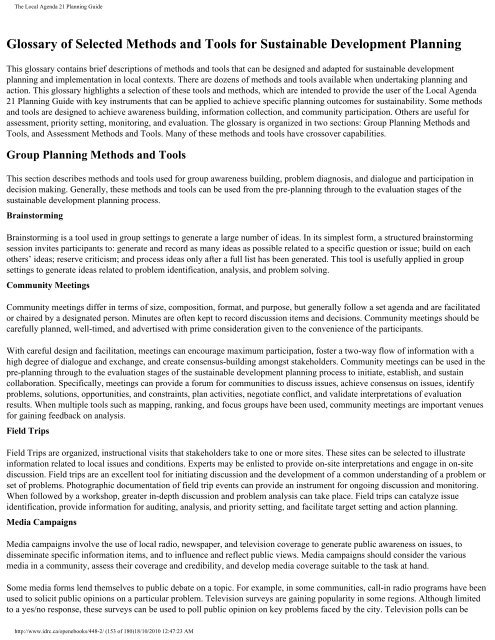The Local Agenda 21 Planning Guide - Democrats Against UN ...
The Local Agenda 21 Planning Guide - Democrats Against UN ...
The Local Agenda 21 Planning Guide - Democrats Against UN ...
Create successful ePaper yourself
Turn your PDF publications into a flip-book with our unique Google optimized e-Paper software.
<strong>The</strong> <strong>Local</strong> <strong>Agenda</strong> <strong>21</strong> <strong>Planning</strong> <strong>Guide</strong><br />
Glossary of Selected Methods and Tools for Sustainable Development <strong>Planning</strong><br />
This glossary contains brief descriptions of methods and tools that can be designed and adapted for sustainable development<br />
planning and implementation in local contexts. <strong>The</strong>re are dozens of methods and tools available when undertaking planning and<br />
action. This glossary highlights a selection of these tools and methods, which are intended to provide the user of the <strong>Local</strong> <strong>Agenda</strong><br />
<strong>21</strong> <strong>Planning</strong> <strong>Guide</strong> with key instruments that can be applied to achieve specific planning outcomes for sustainability. Some methods<br />
and tools are designed to achieve awareness building, information collection, and community participation. Others are useful for<br />
assessment, priority setting, monitoring, and evaluation. <strong>The</strong> glossary is organized in two sections: Group <strong>Planning</strong> Methods and<br />
Tools, and Assessment Methods and Tools. Many of these methods and tools have crossover capabilities.<br />
Group <strong>Planning</strong> Methods and Tools<br />
This section describes methods and tools used for group awareness building, problem diagnosis, and dialogue and participation in<br />
decision making. Generally, these methods and tools can be used from the pre-planning through to the evaluation stages of the<br />
sustainable development planning process.<br />
Brainstorming<br />
Brainstorming is a tool used in group settings to generate a large number of ideas. In its simplest form, a structured brainstorming<br />
session invites participants to: generate and record as many ideas as possible related to a specific question or issue; build on each<br />
others’ ideas; reserve criticism; and process ideas only after a full list has been generated. This tool is usefully applied in group<br />
settings to generate ideas related to problem identification, analysis, and problem solving.<br />
Community Meetings<br />
Community meetings differ in terms of size, composition, format, and purpose, but generally follow a set agenda and are facilitated<br />
or chaired by a designated person. Minutes are often kept to record discussion items and decisions. Community meetings should be<br />
carefully planned, well-timed, and advertised with prime consideration given to the convenience of the participants.<br />
With careful design and facilitation, meetings can encourage maximum participation, foster a two-way flow of information with a<br />
high degree of dialogue and exchange, and create consensus-building amongst stakeholders. Community meetings can be used in the<br />
pre-planning through to the evaluation stages of the sustainable development planning process to initiate, establish, and sustain<br />
collaboration. Specifically, meetings can provide a forum for communities to discuss issues, achieve consensus on issues, identify<br />
problems, solutions, opportunities, and constraints, plan activities, negotiate conflict, and validate interpretations of evaluation<br />
results. When multiple tools such as mapping, ranking, and focus groups have been used, community meetings are important venues<br />
for gaining feedback on analysis.<br />
Field Trips<br />
Field Trips are organized, instructional visits that stakeholders take to one or more sites. <strong>The</strong>se sites can be selected to illustrate<br />
information related to local issues and conditions. Experts may be enlisted to provide on-site interpretations and engage in on-site<br />
discussion. Field trips are an excellent tool for initiating discussion and the development of a common understanding of a problem or<br />
set of problems. Photographic documentation of field trip events can provide an instrument for ongoing discussion and monitoring.<br />
When followed by a workshop, greater in-depth discussion and problem analysis can take place. Field trips can catalyze issue<br />
identification, provide information for auditing, analysis, and priority setting, and facilitate target setting and action planning.<br />
Media Campaigns<br />
Media campaigns involve the use of local radio, newspaper, and television coverage to generate public awareness on issues, to<br />
disseminate specific information items, and to influence and reflect public views. Media campaigns should consider the various<br />
media in a community, assess their coverage and credibility, and develop media coverage suitable to the task at hand.<br />
Some media forms lend themselves to public debate on a topic. For example, in some communities, call-in radio programs have been<br />
used to solicit public opinions on a particular problem. Television surveys are gaining popularity in some regions. Although limited<br />
to a yes/no response, these surveys can be used to poll public opinion on key problems faced by the city. Television polls can be<br />
http://www.idrc.ca/openebooks/448-2/ (153 of 180)18/10/2010 12:47:23 AM










